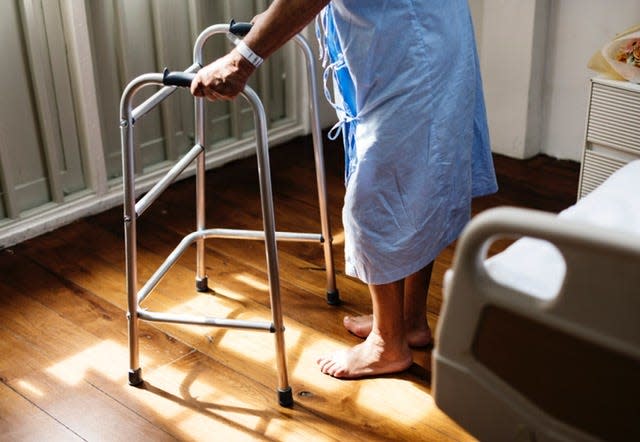Harkins: PA nursing home administrators must stop stonewalling caregivers
With $600 million more in state budget funding earmarked for nursing homes and long-term care, Pennsylvania nursing home operators and staff should be sitting down at the table working out how those dollars can be used to address staff shortages and improve patient care.
Instead, on Friday morning, hundreds of caregivers at facilities across the state walked off the job and joined picket lines.
More:'Trying to get ... appreciated': Workers at 14 Pennsylvania nursing homes go on strike
Why?
Because they believed that as front-line caregivers and the ones best positioned to understand residents' needs, they would have a meaningful say as to how the new funding would be used.
They believed that after years of working at understaffed, underfunded facilities; facing impossible shortages they sometimes tried to meet by digging into their own pockets; and pleading for better resources on behalf of residents; their voices would be heard.
And they believed that with hundreds of millions allocated and a new state law mandating that 70% of costs go to resident-related care, they would find a receptive ear and a welcome spot at the bargaining table as they advocated for needed resources — including a living wage to recruit and retain desperately needed staff.
Instead, what workers at several of the state's largest chains encountered were administrators withholding information, refusing to negotiate fairly and threatening to fire them if they attempted to strike.
No doubt, workers appreciated the gravity of those threats.

But they also understood that the system is at a critical juncture: with millions allocated to address staff shortages and deteriorating conditions, corporate accountability and transparency regarding where those public dollars will go is more important than ever. Clearly, workers need a say, and a place at the table, when it comes to how we treat our most vulnerable residents.
Sounding the alarm
Staffing shortages and insufficient resources are a familiar story to caregivers. At a recent rally at the state Capitol, certified nursing assistant Shelley Robinson recalled what happened when the nursing home she worked for ran out of food.
"Workers were using their own food stamps to run to the store and buy milk and cereal for our residents. We took turns buying snacks for our diabetic patients so their sugar would stay stable. Our paychecks bounced. We are here to take care of our residents, but who is taking care of us?"
Robinson's story isn't unique, and it isn't new. Long before the pandemic, workers at the state's nursing homes have been dealing with understaffed, overworked conditions — in some cases caring for more than 30 patients at a time.
These caregivers are the heart and soul of our long-term care system.
Many have devoted years of their lives to jobs that are incredibly stressful, physically demanding, emotionally draining and chronically low-paying. They perform back-breaking labor — including cleaning and turning patients, changing soiled bedsheets and maneuvering heavy equipment — all while providing lifesaving care and emotional support. Many remained on the front lines working to save lives during the pandemic, despite deadly risks to their own safety.
Yet many earn little more than fast-food and convenience store workers.
This year, we took a huge step toward changing that dynamic. In addition to allocating millions in federal stimulus dollars, the new state budget we passed includes a 17.5% increase in the Medicaid reimbursement rate — about $35 per resident — to better reflect the costs of treating lower-income residents.
I fought hard to get this funding into the new state budget so it could be used as intended — to be invested back into the system to address caregiver concerns, and to help facilities build a stronger workforce by paying the living wage and benefits that are key to retaining and recruiting staff.
Instead, we are hearing reports of private investors buying up nursing homes and hiring outside agencies to staff them. We are hearing about administrators refusing to disclose information on contract workers, so there is no transparency into where those dollars are going.
With new funding in the budget and caregivers pleading for the resources they need, administrators should be listening and looking to meet those demands, not threatening their jobs and contracting with outside agencies.
If we expect caregivers to be there for our most vulnerable residents, we need to ensure that they have the safe staffing levels, living wage and benefits they deserve.
Growing this important workforce now will be critical to help facilities comply with upcoming state regulations that will lower staff-to-patient ratios.

Even more important, it will be critical for meeting a rapidly growing demand: It’s estimated that by 2030, more than 4 million Pennsylvanians — nearly 30% of our population — will be 60 or older. As they continue to age, the majority will require some form of long-term care. We have to be ready for them.

With a system in place and thousands of workers deeply dedicated to improving care, progress is possible. But it can only start with fair and transparent relations between home administrators and staff.
Caregivers have been sounding the alarm for decades. It's time for nursing home administrators to stop stonewalling and start listening. The lives of our most vulnerable Pennsylvanians are hanging in the balance.
State Rep. Pat Harkins of Erie represents Pennsylvania’s 1st Legislative District.
This article originally appeared on Erie Times-News: Harkins urges PA nursing homes to deal fairly with striking caregivers

